This is my second favorite magazine. Let's see what we have this month. Japanese maples on the cover. Always love those. I have the wind blowing leaves from an unknown Japanese maple into my garden. Which is nice.
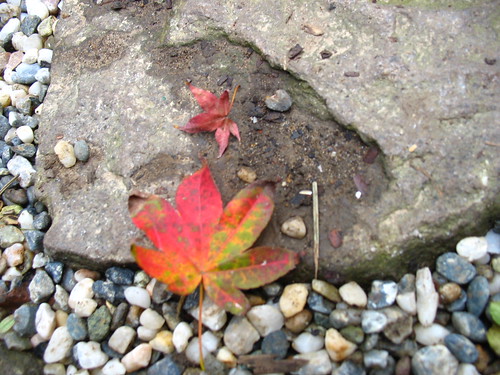
I have the west coast native equivalent, Acer circinatum. It's still very small tho', and dropped all its leaves several weeks ago. More of an Oregon, Washington native, but we have some in northern California too. Because California's a really big state, we get to say we have an incredible diversity of native plants. Anyway, that's neither here nor there.
I was going to get a Japanese maple this year, but by the time I got around to it, they'd all dropped their leaves at the nursery and it was too late to pick. But couldn't I just go with a trusted recommendation? I mean, whatever it is, I'll like it, right?
Fine Gardening recommends: Waterfall, Inaba shidare, Mikawa yatsubusa, Aka shigitatsu sawa (which is the one that captivates me most), Shin deshojo (captivates me second most), Seiryu, Koto no ito, Sango kaku (that's one I've heard of before), Aconitifolium, and Vitifolium.
Aka shigitatsu sawa. Zones: 6 to 8, Height: 7-9 feet, Spring color: green, pink, red. Summer color: Green, pink, red. Fall color: Red
Sounds good.
Shin deshojo. Zones: 6 to 8, Height 10-12 feet, Spring color: red. summer color: red, green. Fall color: red, orange. And they add, "This cultivar's form naturally becomes a 10- to 12-foot-tall haystack, or the tree can be opened up to reveal its architecture through pruning."
Well, I'd like to have green, pink, and red during the spring and summer, and orange and red in the winter. Maybe I should get both.
Sunset's recommendations for Japanese maples (Sunset zones 2-10, 12, 14-24) back in November 2005 (but which I'm certain I read in August '05): For yellow-gold fall color, it's Aoyagi, Flavescens, Hogyoku, Koto no ito, and Sango Kaku. For
orange-red, it's Nicholsonii or Orangeola. For red, it's Bloodgood or Osakazuki.
They also suggest five for container culture: Fjellheim, Kamagata, Mikawa, Yatsubusa, Sharp's Pygmy.
[Note: as I sit here typing, we're having a seriously windy rain storm. I need to show you a movie of my neighbor's yard blowing around. It's incredible. I would be unsurprised if the tree dahlia doesn't make it through the night. Another good reason not to have that plant next year. A small branch broke off it last night. I just hope my neighbor's trellis doesn't come off his house and crush my tree fern. Eventually, it's going to. Sigh.]
Back to Fine Gardening...
The featured garden in this issue belongs to Brigit Piskor in Vancouver. She made "every fence, trellis, container, and sculpture in her garden herself." Wow! What an achievement, huh? [Note: Whoreticulture readers can look forward to future blog posts on the subject of hypertufa. Books have been ordered, I'll be picking up a bag of Portland cement next weekend...] In a small garden, Piskor emphasizes the importance of thin, airy plants. I'm particularly impressed with the self-sown mulleins and Culver's root, Veronicastrum virginicum f. album. Looking at pictures of her beautiful garden, I suddenly feel that I must build by own arbor. Okay, that'll happen after the hypertufa.
A plant I really like in this issue is Dryopteris erythrosora 'Brilliance'. I want a few other ferns in my garden to echo the tree fern, but I don't want to add any more predominantly green plants for awhile either. Ta da! Problem solved. They're only $6.99. I'll take three.
At least one of them will go somewhere in here.
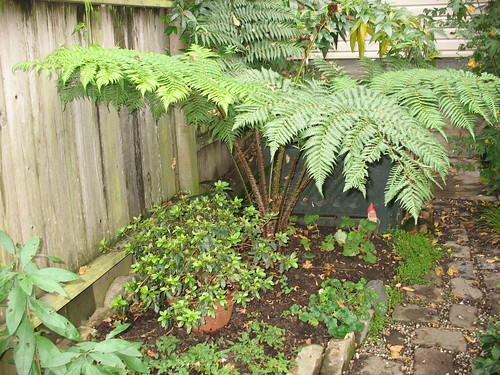
Okay, what disappoints you more--the azalea or the gnome?
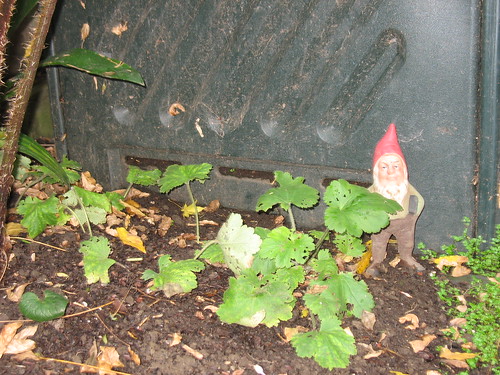
The azalea's just a temporary in that spot, but the gnome stays. He guards the compost bin from the raccoon. That area's real shady. I've got three clivia behind the fern, some tiarella and heuchera (I intended for there to be a lot more heuchera, but most of the divisions I took from elsewhere in the yeard died--to my surprise. These look like they'll make it if they survive the winter.), and hopefully the Symphoricarpus I planted a few weeks ago will take off next spring.
The other thing I have for that spot is the Fuchsia boliviana alba. Still seedlings, but coming along.
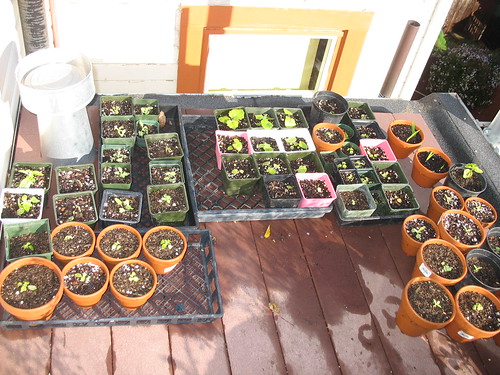
I've got seeds everywhere.
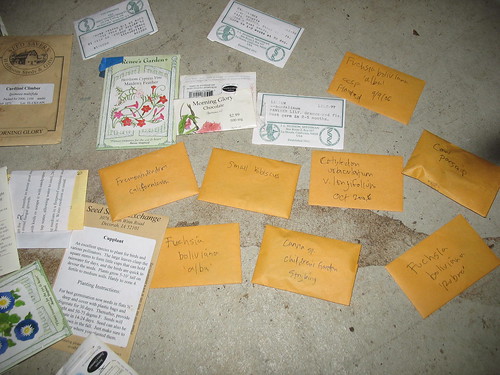
In every drawer.
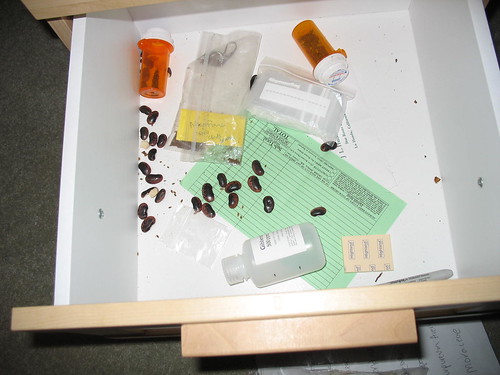
In the refrigerator with extra bulbs I'm not sure what I'm going to do with.
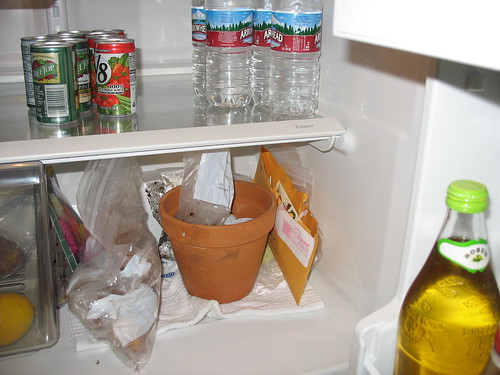
My boyfriend is very sweet to let me have a little corner of our refrigerator for my germination trials.
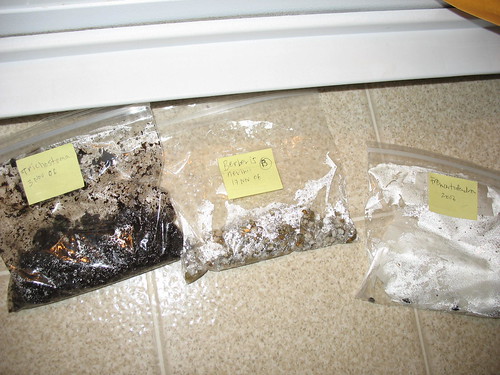
I have extra bulbs because I got a bag of them for my birthday. I can't even remember ever seeing a hyacinth flower before. Do you think it will be okay in this set up?

I figure the roots will anchor themselves in the shells and hold the bulb upright. It's a pretty small flower, right?
Remember that Berberis wilsoniae? Look how red.
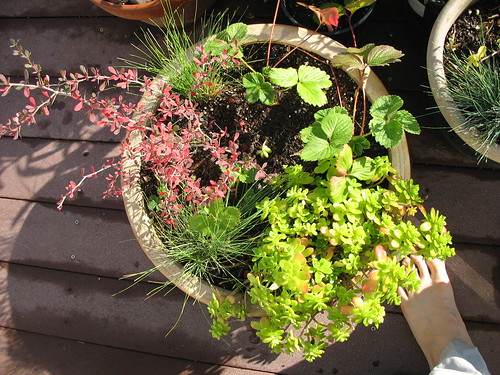

10 comments:
There are some Japanese maples around Austin - not that many- but some. People will try every known trick to coax those lovely trees to live in Texas. One of these days I might try one myself.
Now hypertufa is something my husband has done for years. Here's one of his original troughs, over 10 years old last summer:
http://annieinaustin.blogspot.com/2006/07/tough-enough-trough.html
Good luck with your new projects!
Annie at the Transplantable Rose
Annie, about how much do your hypertufa troughs weigh? They look very nice. I want mine to weigh not very much. (I tried to post that question in the comments on your blog at the link, but for some reason got a bad connection. Hopefully, it will work here.)
Chuck, the Hypertufa is still pretty heavy compared to Terralite pots, because there's still a lot of Portland cement in it - my husband estimates the trough has about half the weight of an all concrete one... the trough in the photo is probably 28-35 pounds without soil. On the other hand, I've had to put bricks in the bottom of my lightweight commercial pots so they don't constantly blow over, and these are stable.
Annie at the Transplantable Rose
PS Forced hyacinths are very top heavy, and the flower head might weigh more than the bulb, roots and leaves all together once it opens. Maybe you could take out a few shells so the bulb sits a little lower in the glass, and use the extra shells between glass wall and bulb to keep the bulb from tipping over?
Remind me -- what's your favorite magazine?
I force hyacinth bulbs every year, starting right after Christmas. You will enjoy the smell, especially. But as Annie noted, they will be a bit top heavy.
Maybe I'll put some extra shells around the bulb as it is to stabilize it. Maybe if it starts to lean I'll have the makings of a comical blog post.
My favorite "magazine", which every western gardener should read is Pacific Horticulture. I read every issue cover-to-cover, and I aggressively seek out back issues. I looove that Pacific Horticulture.
I would find your gnome less offensive if he were accompanied by Aunt Jamima and Uncle Mose.
If you have a large potted tree/plant that may become too heavy, you can use styrofoam packing peanuts or crushed aluminum cans in the bottom 1/3 below the soil to help keep it lighter. I did this with my norfolk island pine, and it's big but manageable for me to haul out in summer and back in in winter. As for your hyacinth bulb-Annie's right about the weight, and as roots form, you'll want to keep water away from the bottom of the bulb itself, or it may rot. (Just let water cover the roots.)
My personal opinion?
Hyaciths stink. Stink. I don't know how folks can stand that cloying odor.
I know, I'm a freak.
No hyacinths for me, thanks. I'll stick with amaryllis...
Speaking of cloying odors...Does anyone have experience smelling the Cestrum nocturnum? I bought a cutting last year on eBay (from someone in Austin. Annie?) and it's on it's way up in my garden. Should be interesting...
I have Cestrum auranticum too--much farther along. It's amazing how bad Cestrum leaves smell, huh? The flowers are nice and slightly fragrant.
Post a Comment